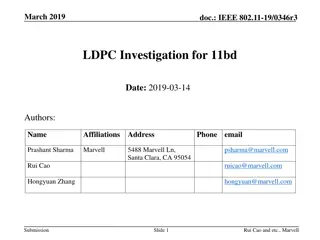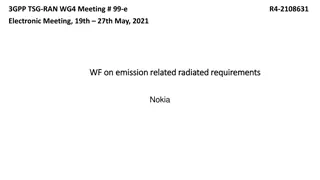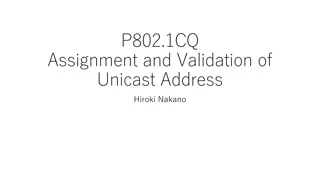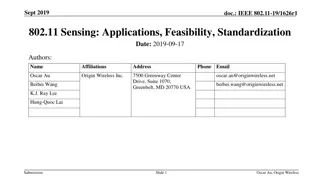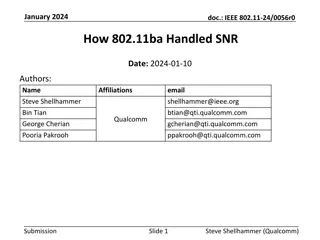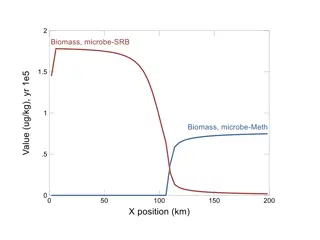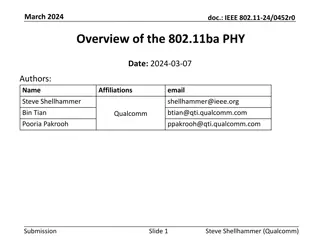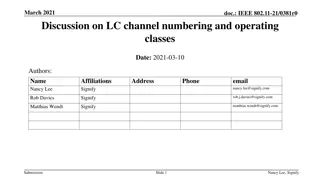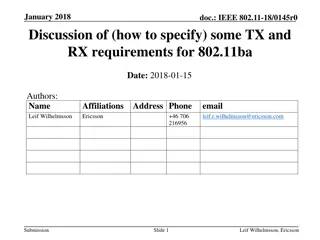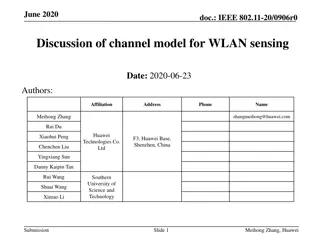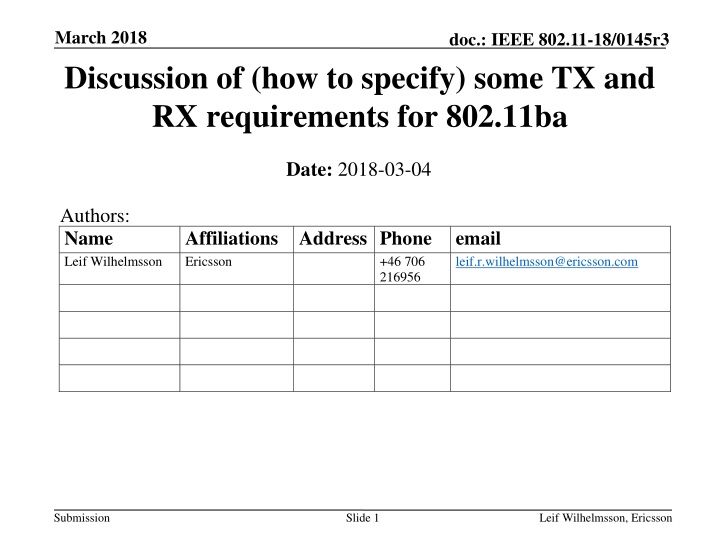
802.11ba Transmitter and Receiver Requirements Discussion
Explore the March 2018 discussion on specifying TX and RX requirements for 802.11ba, including topics like spectrum masks, modulation accuracy, receiver sensitivity, and more. Get insights on aligning views within the PHY group and seeking feedback from the TG.
Download Presentation

Please find below an Image/Link to download the presentation.
The content on the website is provided AS IS for your information and personal use only. It may not be sold, licensed, or shared on other websites without obtaining consent from the author. If you encounter any issues during the download, it is possible that the publisher has removed the file from their server.
You are allowed to download the files provided on this website for personal or commercial use, subject to the condition that they are used lawfully. All files are the property of their respective owners.
The content on the website is provided AS IS for your information and personal use only. It may not be sold, licensed, or shared on other websites without obtaining consent from the author.
E N D
Presentation Transcript
March 2018 Discussion of (how to specify) some TX and RX requirements for 802.11ba doc.: IEEE 802.11-18/0145r3 Date: 2018-03-04 Authors: Name Leif Wilhelmsson Affiliations Address Phone Ericsson email leif.r.wilhelmsson@ericsson.com +46 706 216956 Submission Slide 1 Leif Wilhelmsson, Ericsson
March 2018 doc.: IEEE 802.11-18/0145r3 Abstract When working on the PHY specification text, we realized we don t have many agreements on TX and RX requirements Within the small PHY group we seem to start to align our views!? The purpose of this presentation is to report about what has been discussed and get feedback from the TG Submission Slide 2 Leif Wilhelmsson, Ericsson
March 2018 doc.: IEEE 802.11-18/0145r3 Outline Transmitter Spectrum mask Modulation accuracy Receiver Receiver sensitivity Adjacent channel rejection Maximum input level Submission Slide 3 Leif Wilhelmsson, Ericsson
March 2018 doc.: IEEE 802.11-18/0145r3 Transmitter: Spectrum mask The first question is whether it suffice to fulfill the 20 MHz TX mask for the PCR If the answer is yes, we are done The figures above are just for illustration (OBO = 3 dB, windowing applied (1 sample at 20 MHz)) Submission Slide 4 Leif Wilhelmsson, Ericsson
March 2018 doc.: IEEE 802.11-18/0145r3 Transmitter: Spectrum mask The spectrum becomes dependent on the selected waveforms selected for the ON part of the signal, above is one example Should we have different spectrum masks for MCS0 and MCS1, or just one that should be fulfilled for both? MCS1 expected to generate wider spectrum Details TBD once the waveforms are decided Submission Slide 5 Leif Wilhelmsson, Ericsson
March 2018 doc.: IEEE 802.11-18/0145r3 Transmitter: Modulation accuracy This is where EVM is used in e.g. 802.11ac Since the receiver is non-coherent, one may use a similar measure as is done to test an FSK transmitter, i.e., considering an ideal eye-diagram The figure above is taken from the Bluetooth spec. Submission Slide 6 Leif Wilhelmsson, Ericsson
March 2018 Methodology for TX evaluation - OFDM doc.: IEEE 802.11-18/0145r3 Spectrum analyzer Shaping OFDM OFDM SINR PA + CSF WGN For coherent demodulation, the modulation accuracy is typically specified by means of transmitted Error Vector Magnitude (EVM). Note that the EVM is representative for how well a receiver will work The requirement on EVM is dependent on MCS. Essentially the EVM should be comparably small at the SNR where the MCS is expected to operate In addition to the requirement on EVM, the spectrum of the transmitted signal should also fulfill the TX spectrum mask Submission Slide 7 Leif Wilhelmsson, Ericsson
March 2018 Methodology for TX evaluation - OOK doc.: IEEE 802.11-18/0145r3 Env. Det. Shaping OOK OFDM + CSF PA WGN For OOK, the receiver is expected to be based on an envelope detector. A possibility is to test the modulation using an ideal receiver according to the Simulation Methodology document White Gaussian noise is here added for the purpose to discuss reasonable requirements for the transmitter as the PA will not limit the accuracy as in case of EVM Submission Slide 8 Leif Wilhelmsson, Ericsson
March 2018 doc.: IEEE 802.11-18/0145r3 Transmitter: Modulation Accuracy Possible requirements for modulation accuracy: Zero-crossing error (TBD us) Max eye-opening ( > TBD % of ideal eye-opening) Submission Slide 9 Leif Wilhelmsson, Ericsson
March 2018 doc.: IEEE 802.11-18/0145r3 Simulation Results Fixed sequence SNR = 10dB SNR = 100dB SNR = 0dB The specification should just ensure that TX imperfections only cause negligible receiver degradation Say the receiver is operating at SNR = 0dB, then there is probably no need have an eye-diagram better than then one corresponding to 10 dB above Submission Slide 10 Leif Wilhelmsson, Ericsson
March 2018 doc.: IEEE 802.11-18/0145r3 Simulation Results Impact of PA OBO OBO = 10dB OBO = 0dB Opposite to e.g. QAM, the PA saturation is good! The reason is that the transmitted signal becomes closer to ideal OOK . At the cost of spectrum re-growth Submission Slide 11 Leif Wilhelmsson, Ericsson
March 2018 doc.: IEEE 802.11-18/0145r3 Simulation Results Random data vs. fixed seq. Random QPSK data Fixed sequence The variations in case of a random data is due to that although ??? envelope detector uses ???, which varies ? = constant for all ON symbols, the Submission Slide 12 Leif Wilhelmsson, Ericsson
March 2018 doc.: IEEE 802.11-18/0145r3 Receiver: Sensitivity According to the PAR The WUR is a companion radio to the primary connectivity radio and meets the same range requirement as the primary connectivity radio Because of different regulatory rules in different regions of the world, the maximum allowed TX power may be different than that of the PCR [2] To achieve the same range when the TX power is less for the WUR, a better sensitivity is required [2],[3] Submission Slide 13 Leif Wilhelmsson, Ericsson
March 2018 doc.: IEEE 802.11-18/0145r3 Receiver: Sensitivity The improved sensitivity has up until now been taken into account by, relative to the PCR, having a required SNR that is [3] 12 dB lower in 2.4 GHz frequency band 15 dB lower in 5 GHz frequency band The PHY group feels that we should not require the same range, but should instead require the same sensitivity This would effectively test the demodulator and that the NF is not too high, but will not take a potential lower TX power into account Submission Slide 14 Leif Wilhelmsson, Ericsson
March 2018 doc.: IEEE 802.11-18/0145r3 Receiver: Sensitivity The good thing with specifying sensitivity is that It makes the specification simpler It is a relaxation, and therefore allows for that the WUR can be made more power efficient The bad thing, at least according to me, is that it does not fulfil the spirit of the PAR Submission Slide 15 Leif Wilhelmsson, Ericsson
March 2018 doc.: IEEE 802.11-18/0145r3 Receiver: Adjacent channel rejection Also for ACR, different TX power may have an impact since the experienced SIR will differ as much as the TX powers PCR: -70dBm WUR:-77dBm I: -55 dBm PCR: 23dBm WUR: 16dBm PCR: SIR= -15dB WUR:SIR=-22dB Submission Slide 16 Leif Wilhelmsson, Ericsson
March 2018 doc.: IEEE 802.11-18/0145r3 Receiver: Adjacent channel rejection Consider MCS0. PCR power is then set at -79dBm and interference level should be at least -63dBm with a working PCR (ACR should be at least 16dB) If the received power is the same for the WUR, ACR = 16 dB would make sense also for WUR If the required sensitivity is scaled with TX power, e.g. -89 dBm, ACR = 23dB makes sense for withstanding the same interference power If the required sensitivity is -82, is seems we are back at -16dBm. Effectively ACR is relaxed as much as sensitivity Submission Slide 17 Leif Wilhelmsson, Ericsson
March 2018 doc.: IEEE 802.11-18/0145r3 Maximum input level The 802.11 specification requires -30dBm OOK would typically be less sensitive to compression in the front-end Unless there is a use case that require more stringent requirements, the suggestion is to also have -30 dBm for the WUR Submission Slide 18 Leif Wilhelmsson, Ericsson
March 2018 doc.: IEEE 802.11-18/0145r3 References [1] S. Azizi et al. A PAR Proposal for Wake-up Radio , 11- 16/1045r9 [2] S. Shellhammer and B. Tian, Regulations and noise figure - Impact on SNR , 11-17/0365r0 [3] S. Shellhammer and B. Tian, WUR data rates , 11- 17/0990r2 Submission Slide 19 Leif Wilhelmsson, Ericsson
March 2018 doc.: IEEE 802.11-18/0145r3 Straw Poll 1 Do you believe the transmitter spectrum mask should be the same as today used for 20 MHz 802.11ac? Y/N/A: 20/1/9 Submission Slide 20 Leif Wilhelmsson, Ericsson
March 2018 doc.: IEEE 802.11-18/0145r3 Motion 1 Move to add the following into the 11ba SFD The transmitter spectrum mask for the WUR transmitter should be the same as today used for 20 MHz 802.11ac. Move: Leif Wilhelmsson Second: Submission Slide 21 Leif Wilhelmsson, Ericsson
March 2018 doc.: IEEE 802.11-18/0145r3 Straw Poll 2 Do you support the idea of specifying the transmitter accuracy by means of an eye-diagram? Exactly how is TBD, but a possibility would be to specify zero- crossings and max eye-opening as discussed in this presentation Y/N/A: 1/11/26 Submission Slide 22 Leif Wilhelmsson, Ericsson
March 2018 doc.: IEEE 802.11-18/0145r3 Straw Poll 3 Do you believe only one sensitivity requirement should be specified for the lower rate, even if this means different relative ranges for the PCR and the WUR in different parts of the world? Y/N/A: 13/0/19 Submission Slide 23 Leif Wilhelmsson, Ericsson
March 2018 doc.: IEEE 802.11-18/0145r3 Straw Poll 4 If only one sensitivity requirement is specified for the lower rate, what is the number you prefer? OP1:-82dBm/OP2:-86dBm/OP3:-89dBm/OP4:Something else/OP5:No opinion OP1/OP2/OP3/OP4/OP5: 17/2/0/0/6 Submission Slide 24 Leif Wilhelmsson, Ericsson
March 2018 doc.: IEEE 802.11-18/0145r3 Motion 2 Move to add the following into the 11ba SFD The sensitivity requirement for the lowest rate of the WUR is -82dBm. Move: Leif Wilhelmsson Second: Submission Slide 25 Leif Wilhelmsson, Ericsson
March 2018 doc.: IEEE 802.11-18/0145r3 Straw Poll 5 Assume that ACR is specified independent of what maximum TX power can be used. ACR is measured in the same way as for the PCR and the interfering signal is also the same as for the PCR. What do you believe the ACR for lower data rate should be? OP1:16dB/OP2:20dB/OP3:23dB/OP4:Something else/OP5:No opinion OP1/OP2/OP3/OP4/OP5: 25/0/0/0/5 Submission Slide 26 Leif Wilhelmsson, Ericsson
March 2018 doc.: IEEE 802.11-18/0145r3 Motion 3 Move to add the following into the 11ba SFD The adjacent channel rejection (ACR) is measured in the same way as for the PCR and the interfering signal is also the same as for the PCR. The adjacent channel rejection (ACR) requirement for the lowest rate of the WUR is 16dB. Move: Leif Wilhelmsson Second: Submission Slide 27 Leif Wilhelmsson, Ericsson
March 2018 doc.: IEEE 802.11-18/0145r3 Straw Poll 6 Do you support that the maximum input level is the same as for the PCR? Y/N/A: 29/0/3 Submission Slide 28 Leif Wilhelmsson, Ericsson
March 2018 doc.: IEEE 802.11-18/0145r3 Motion 4 Move to add the following into the 11ba SFD The requirement on the received signals maximum input level is the same as for the PCR. Move: Leif Wilhelmsson Second: Submission Slide 29 Leif Wilhelmsson, Ericsson






